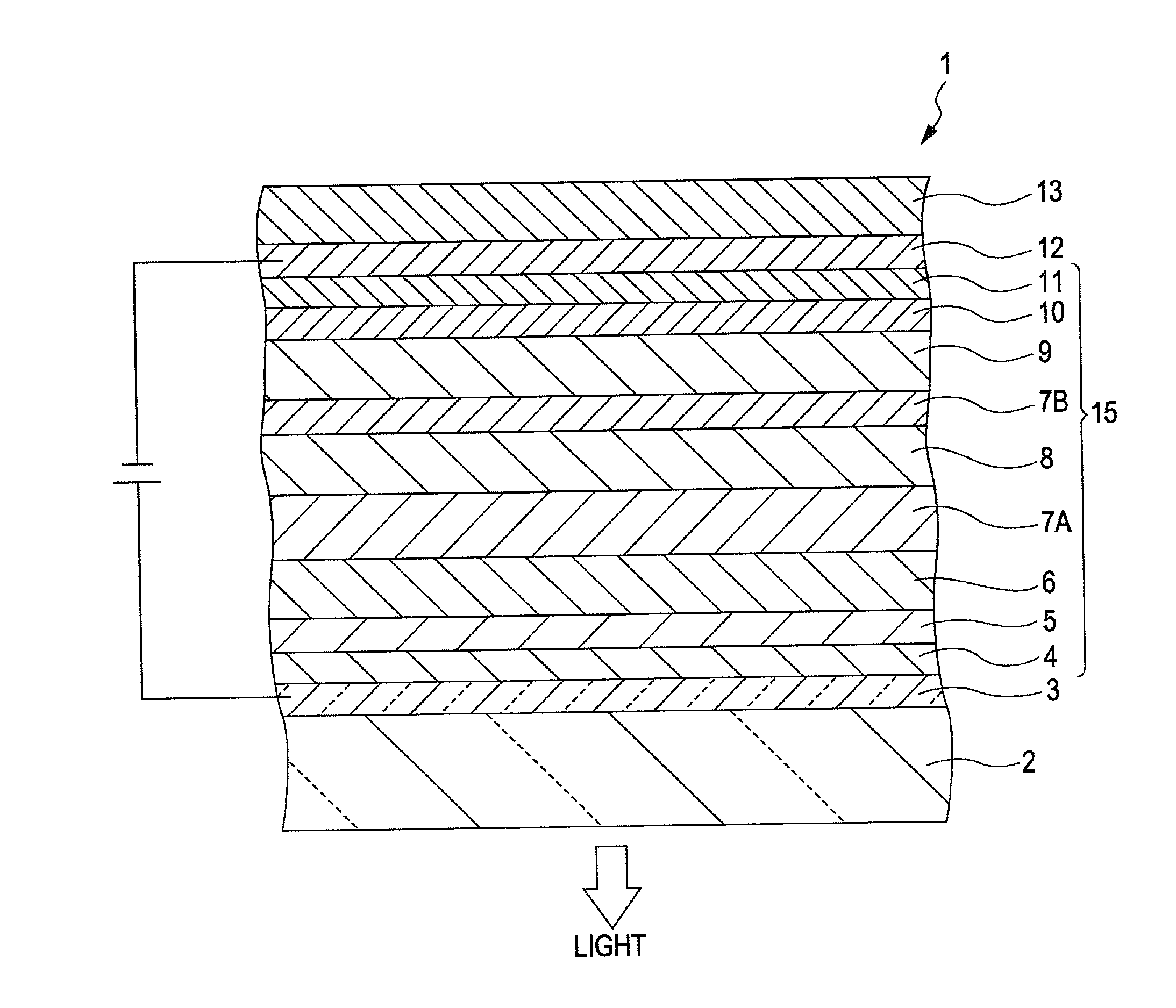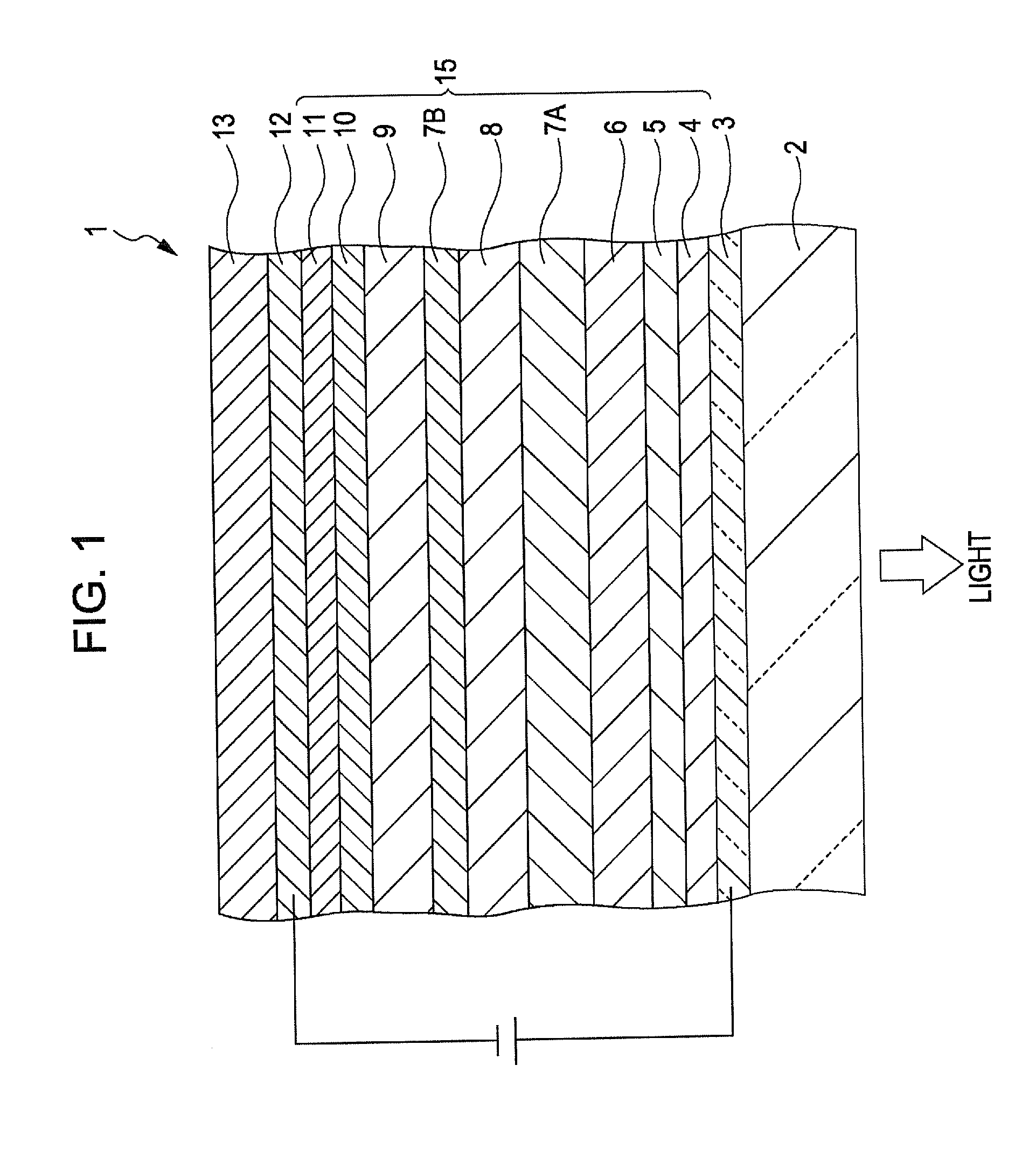Film-forming ink, film-forming method, method of manufacturing light emitting element, light emitting element, light emitting device, and electronic apparatus
a film-forming method and film-forming technology, applied in the direction of non-metal conductors, thermoelectric devices, conductors, etc., can solve the problems of low desolvation properties, lack of preservation stability, and increase in gelation and viscosity, and achieve the effect of superior reliability
- Summary
- Abstract
- Description
- Claims
- Application Information
AI Technical Summary
Benefits of technology
Problems solved by technology
Method used
Image
Examples
first embodiment
Light Emitting Element
[0072]FIG. 1 is a cross-sectional view schematically illustrating a light emitting element according to an embodiment of the invention. Hereinafter, for convenience of description, the upper side and lower side of FIG. 1 are considered as “up” and “down” respectively.
[0073]A light emitting element (electroluminescence element) 1 illustrated in FIG. 1 emits red light (R), green light (G), and blue light (B) to emit white light.
[0074]In such a light emitting element 1, between an anode 3 and a cathode 12, a hole injection layer 4, a hole transport layer 5, a red-light emitting layer (first light emitting layer) 6, a first interlayer 7A, a blue-light emitting layer (second light emitting layer) 8, a second interlayer 7B, a green-light emitting layer (third light emitting layer) 9, an electron transport layer 10, and an electron injection layer 11 are laminated in this order.
[0075]In other words, the light emitting element 1 has a configuration in which a laminate ...
second embodiment
[0273]A second embodiment is different from the first embodiment in that light emitting elements are formed by elements which emit red light, green light, and blue light, respectively.
[0274]Next, a light emitting device including light emitting elements, which are manufactured according to the method of manufacturing a light emitting element according to the embodiment, will be described with reference to FIGS. 8 and 9. FIG. 8 is a front view schematically illustrating a configuration of the light emitting device according to the embodiment, and FIG. 9 is a cross-sectional view schematically illustrating structures of major components in the light emitting device according to the embodiment.
[0275]As illustrated in FIG. 8, an organic EL device 240 according to the embodiment includes an element substrate 201 which includes three colors (R (red), G (green), and B (Blue)) of light emitting pixels 207, and a sealing substrate 202 which is disposed facing the element...
example 1
[0387] First, a transparent glass substrate having an average thickness of 0.5 mm was prepared. Next, an ITO electrode (anode) having an average thickness of 100 nm was formed on the substrate with a sputtering method.
[0388]Then, the substrate was dipped in acetone and 2-propanol in this order, followed by washing with ultrasonic waves and oxygen plasma treatment.
[0389] Next, a hole injection layer having an average thickness of 50 nm was formed on the ITO electrode.
[0390]This hole injection layer was formed by applying a hole-injection-layer-forming ink onto the ITO electrode with a liquid droplet discharge method and performing drying in a vacuum and heating (calcination) at 150° C. for 30 minutes in a nitrogen atmosphere.
[0391]For the preparation of the hole-injection-layer-forming ink, PEDOT / PSS (1 / 20) was used as the film-forming material; and a mixed dispersion medium, which included polystyrene sulfonic acid, 3,4-polyethylenedioxythiophene as a polythiophene derivative, and w...
PUM
| Property | Measurement | Unit |
|---|---|---|
| thickness | aaaaa | aaaaa |
| thickness | aaaaa | aaaaa |
| thickness | aaaaa | aaaaa |
Abstract
Description
Claims
Application Information
 Login to View More
Login to View More - R&D
- Intellectual Property
- Life Sciences
- Materials
- Tech Scout
- Unparalleled Data Quality
- Higher Quality Content
- 60% Fewer Hallucinations
Browse by: Latest US Patents, China's latest patents, Technical Efficacy Thesaurus, Application Domain, Technology Topic, Popular Technical Reports.
© 2025 PatSnap. All rights reserved.Legal|Privacy policy|Modern Slavery Act Transparency Statement|Sitemap|About US| Contact US: help@patsnap.com



